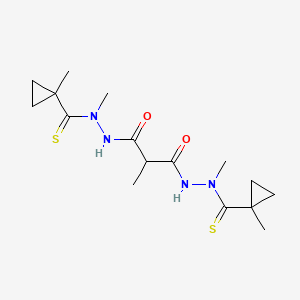|
Name: N-(1-phenethylpiperidin-4-yl)-N-phenyltetrahydrofuran-2-carboxamide
Type: Synthetic opioid
AKA: Tetrahydrofuranyl fentanyl

|
|
II. Natural Derivative
Synthetic substance, no natural derivative
 |
|
III. Chemical Profile (IUPAC name)

|
|
IV. History
N-(1-Phenethylpiperidin-4-yl)-N-phenyltetrahydrofuran-2-carboxamide, a synthetic compound, was developed for research purposes. It is studied for its effects on the central nervous system and potential medical uses.

|
|
V. Legal Information
This synthetic compound is a potent stimulant with potential for abuse. It is controlled under laws governing new psychoactive substances, including in the United States, where it may be regulated to prevent misuse. [Source: UNODC].
US Federal Schedule - I
Schedule I drugs, substances, or chemicals are defined as drugs with no currently accepted medical use and a high potential for abuse. Some examples of Schedule I drugs are: heroin, lysergic acid diethylamide (LSD), marijuana (cannabis), 3,4-methylenedioxymethamphetamine (ecstasy), methaqualone, and peyote.
Key US Federal Policies:
Controlled Substances Act. Public Law: Public Law 91-513 (text can be found on GovInfo) (https://www.dea.gov/drug-information/csa). Date enacted: October 27, 1970.
|
|
VI. Physical Effects
N-(1-Phenethylpiperidin-4-yl)-N-phenyltetrahydrofuran-2-carboxamide is a synthetic compound with potential psychoactive effects. Short-term use may induce euphoria and altered perception, but long-term use poses risks of psychological issues and cardiovascular effects. Overdose risks include severe agitation and cardiovascular issues. Safe use requires careful dosing and monitoring. Recent research explores its psychoactive properties and associated health risks.  |
|
VII. Psychological Effects
This compound, a potent synthetic opioid, interacts with mu-opioid receptors, leading to significant euphoria and sedation. Immediate effects include mood elevation and pain relief, lasting several hours. Long-term use may result in severe addiction, cognitive impairments, and mood disturbances. Research emphasizes its potency and associated risks of psychological dependence and cognitive effects.
 |
|
VIII. Culture
N-(1-Phenethylpiperidin-4-yl)-N-phenyltetrahydrofuran-2-carboxamide is a synthetic opioid with significant analgesic effects, classifying it as a downer. Short-term use alleviates severe pain, while long-term use can lead to dependence and tolerance. Overdose risks are high, potentially causing severe respiratory depression and fatal outcomes. Safe dosages are not well-established, with lower doses advised. Recent research underscores its potency and associated risks. Physical effects include drowsiness, constricted pupils, and respiratory depression.
 |
